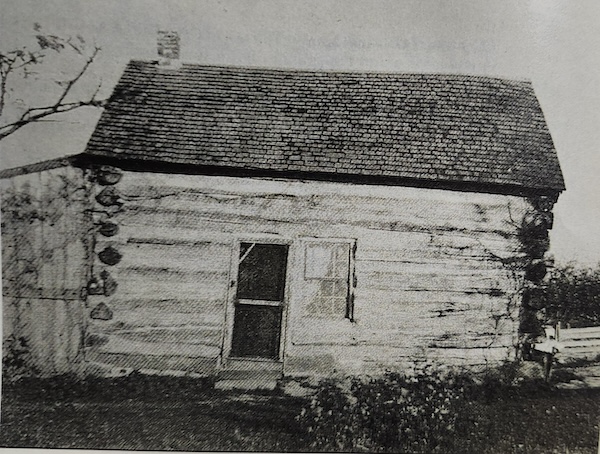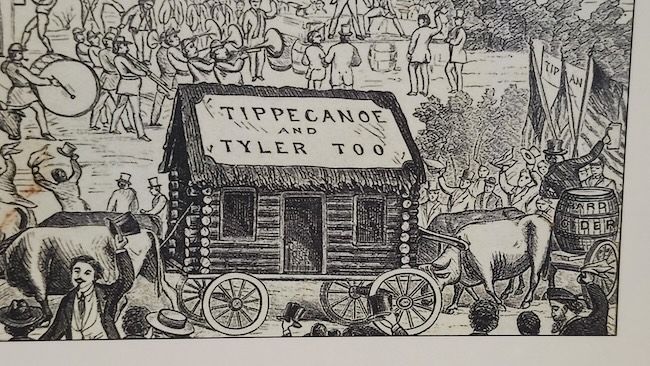Pioneer log cabins spotlighted by speaker at Medina Historical Society

This is a picture of the log cabin which once existed on the Peter Smith Road in the town of Kendall. This was taken from a print Adam Tabelski made from Bill Lattin’s book, Architecture Destroyed. This was the last standing pioneer log cabin in Orleans County, built in 1815 and torn down around 1952.
MEDINA – When the Medina Historical Society asked Adam Tabelski to be the speaker at their October meeting, he chose a subject to tie in with Orleans County’s bicentennial.
“I thought it would be fitting to choose a topic that is associated with the very early days of permanent settlement in our region,” said Tabelski, a Medina native and current resident of Batavia.
His talk focused on the pioneer log cabin because they were the first, small, humble homes of the county’s early settlers.
“Over time, the log cabin culturally and nostalgically came to represent a yearning for earlier, simpler days,” Tabelski said. “Politically and socially, the log cabin came to represent the ‘every man,’ a mark of a humble, democratic upbringing. It captured the American spirit, symbolizing rugged individualism, courage, resourcefulness and ingenuity.”
Tabelski went on to explain there were two types of construction – round log and hewn log. He also explained the reason for log cabins was because there were no saw mills to make boards, no quarries and no bricks, however, there were plentiful tall and straight trees.
A log cabin could be built with just an axe, although pioneers did have saws, adzes and chisels to make their job easier.
Tabelski next shared that a great resource for not only his lecture, but the whole history of Western New York is Orsamus Turner’s 1850 book Pioneer History of the Holland Land Purchase.
Sadly, Tabelski said the number of original log cabins still standing in our area are slim to none.
“I’m not aware of any that are still in their original location,” he said. “Too much time has passed and they simply weren’t built to last.”
Tabelski explained that log cabins were not meant to be permanent homes. They were temporary shelters that allowed families to carve a place for themselves out of the woods, gain a foothold, establish farms and eventually build a house with boards.
‘Politically and socially, the log cabin came to represent the ‘every man,’ a mark of a humble, democratic upbringing. It captured the American spirit, symbolizing rugged individualism, courage, resourcefulness and ingenuity.’
In Bill Lattin’s book, Architecture Destroyed, there is a photograph, circa 1902, of an early log cabin located on the Peter Smith Road in the town of Kendall. It was the last log house of its type in Orleans County until it was torn down in the early 1950s, according to Lattin.
A good example of a real log cabin can be seen at the Genesee Country Village and Museum in Mumford.
An original log cabin can be seen on Route 5 in Clarence, just past the Asa Ransom House. It is called the Goodrich-Landow log cabin and was built around 1852 by Levi Goodrich’s family. It stood on Goodrich Road until moved to Clarence in 1990, where it became the Clarence Historical Society log cabin.
Another well-preserved log house is situated in Letchworth State Park, where it was moved by William Pryor Letchworth. The cabin, built in 1800, belonged to Nancy Jemison, daughter of Mary Jemison, the White Woman of the Genesee.
In Lockport, the Niagara County Historical Society Museum has an area set up to illustrate what would have been found in a log dwelling of the early 19th century. This included candle molds, a foot warmer, dried herbs, a bathtub and rope and trundle beds.

This picture, taken from Adam Tabelski’s booklet of information he compiled for a talk on the history of log cabins, shows how log cabins played a role in the 1840 election of William Henry Harrison as president of the United States. The log cabin, erected on a wagon, was drawn in parades to promote Harrison (known as “Tippecanoe”) and his vice presidential running mate John Tyler.
The log cabin emerged as a key player in the presidential election of 1840, when General William Henry Harrison of Ohio was named to oppose incumbent Democrat Martin Van Buren. Harrison was an older man who gained fame as “Old Tippecanoe” after winning an 1811 battle against Native Americans near the Tippecanoe River in Indiana.
A Democratic newspaper made the mistake of being negative early in the campaign, depicting Harrison as a “feeble old man ready to be put out to pasture.” They editorialized, “Give him a barrel of hard cider and settle a pension of two thousand a year on him, and take my word for it, he will sit the remainder of his days in his log cabin.”
Whig leaders jumped on this characterization (or mischaracterization) and made the log cabin and hard cider indelible emblems of their campaign, wearing them as a badge of honor to connect with every day American citizens. This was the election of “Tippecanoe and Tyler,” too, as John Tyler of Virginia was selected as the vice-presidential candidate.
Across the country, parades and rallies were held with homemade log cabins, sometimes built on wagons and paraded through the streets, and barrels of hard cider. The campaign went into the public square on a scale far more so than ever before.
In Buffalo, a “Tippecanoe log cabin” was built in downtown Buffalo. One thing the Whigs did was create their own national newspaper to support their candidate. The Log Cabin was published by Horace Greeley from May 1840 to November 1841. Its purpose was to back the presidential campaign of Harrison, but by the end of his campaign, circulation had risen to 80,000. This success inspired Greeley to establish the New York Tribune.
The election and log cabin fever eventually hit Albion. According to Ed Grinnell’s book, Medina – Here’s to our Heritage, he recalled the fervor around the 1840 election year. He wrote, “Songs were composed and sung, log cabins built, poles raised. At Albion in June, a log cabin was built. Log cabins with a coon skin tacked on them and a barrel of hard cider were the order of the day.”
While Tabelski’s presentation included much more information about log cabins, this article will conclude with a movement to build a log cabin on the fairgrounds which had been moved to the Bokman farm near Knowlesville in the 1960s.
This log cabin had nothing to do with honoring pioneer legacy, according to Tabelski’s report. It was a project of the Orleans County Federation of Sportsmen’s Clubs, who wanted a place for conservation education activities, and they wanted it made of natural building materials.
Ground was broken for the new log cabin on June 8, 1974, following a sketch made by then young Bill Lattin, whose father at the time was county historian. Today the cabin continues to serve the public as a conservation hub during the Orleans County 4-H Fair.
Tabelski concluded his presentation with slides of a log cabin home on Ryan Road, the Log Cabin Restaurant in Indian Falls and plans to build a log cabin on the grounds of Old Fort Niagara to house a Native American Education Center.
A final page of Tabelski’s presentation lists seven presidents who were born in log cabins – Andrew Jackson, Zachary Taylor, Millard Fillmore, James Buchanan, Abraham Lincoln, Ulysses S. Grant and James Garfield.
Georgia Thomas, a board member of Medina Historical Society, said they had a large turnout for the presentation.
“I loved it, and I knew for anyone not familiar with log cabins and early settlers, it was a plethora of information,” Thomas said. “It was a wonderful program.”



























































